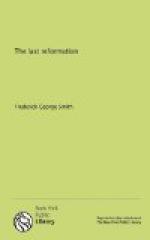[Sidenote: The great red dragon]
The next object in the vision to which our attention is directed is introduced in these words: “And there appeared another wonder in heaven; and behold a great red dragon, having seven heads and ten horns, and seven crowns upon his heads. And his tail drew the third part of the stars of heaven, and did cast them to the earth: and the dragon stood before the woman which was ready to be delivered, for to devour her child as soon as it was born” (Rev. 12:3, 4).
The dragon is the name given by the ancients to a fabulous monster represented as a large winged lizard or serpent. It was regarded as the enemy of mankind, and its overthrow is made to figure among the greatest exploits of the gods and heroes of heathen mythology. The symbol, being drawn from the natural world, directs us by analogy to persecuting, tyrannical government. We must not suppose that this is a literal description of Beelzebub; for there is no proof that the personal devil has any such appearance as this monster with seven heads and ten horns, and a tail dragging after him a third part of the stars of heaven.
In the second verse of the next chapter John describes the rise of a beast that also had seven heads and ten horns; “and the dragon gave him his power, and his seat, and great authority.” The fact that the dragon was succeeded by the beast, who reigned in his stead, is proof that the dragon does not signify the personal devil; for, as far as we know, the archfiend has never resigned his position, but is still doing his infernal business at the same stand.
In many respects the beast is similar to the dragon. In the seventeenth chapter the beast appears again, and the explanation given by the angel will enable us to understand the signification both of the dragon and of the beast. “The beast that thou sawest was, and is not; and shall ascend out of the bottomless pit, and go into perdition ... and here is the mind which hath wisdom. The seven heads are seven mountains, on which the woman sitteth. And there are seven kings: five are fallen, and one is, and the other is not yet come; and when he cometh, he must continue a short space.... And the ten horns which thou sawest are ten kings, which have received no kingdom as yet; but receive power as kings one hour with the beast” (verses 8-12).
With these facts before us and with our understanding of the nature of symbols, it is easy to identify the dragon and the beast as the Roman Empire, first under the pagan form and later under the papal form. Although the beast was to succeed the dragon, yet in identifying the heads of the beast, the angel informed John that in his day five had already fallen, while one then existed and the other was future. This proves, then, that the same heads served both for the dragon and for the beast, thus establishing their essential identity. And it is a fact well known that there is no essential difference between Rome




